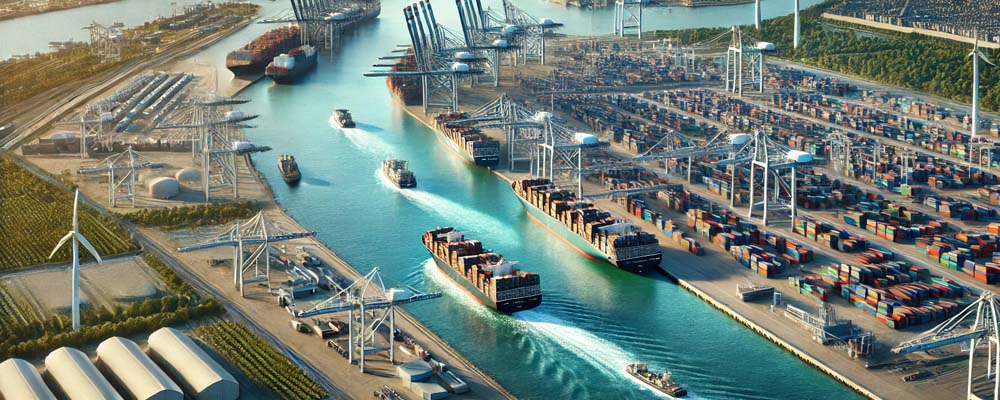
The Port of Antwerp, located in Belgium, is one of the most significant logistics hubs globally. Situated strategically on the River Scheldt, it serves as a gateway between Europe and the rest of the world, playing a crucial role in facilitating international trade. Its extensive infrastructure, technological integration, and commitment to sustainability make it a key player in the logistics industry. This article explores the technical aspects and strategic importance of the Port of Antwerp, focusing on its infrastructure, operational efficiency, environmental initiatives, and future challenges.
1. Infrastructure and Capacity
Size and Connectivity
The Port of Antwerp is the second-largest port in Europe, covering an area of 12,068 hectares. This vast expanse allows it to accommodate a diverse range of cargo and industrial operations. The port ranks among the top 20 globally in terms of throughput, thanks to its well-developed dock network and logistical facilities.
Its location on the River Scheldt is a key factor in its success, offering access to major sea routes while connecting to Europe’s inland transport systems. The port is well integrated with road, rail, and inland waterway networks, making it a highly efficient intermodal hub. For logistics providers and freight forwarding companies, this interconnectivity facilitates the seamless movement of goods across borders.
- Maritime Infrastructure: With over 240 kilometers of quay walls and more than 900 berths, the port can handle various vessel types, including large container ships and bulk carriers. The Kieldrecht lock, one of the largest in the world, ensures that even the largest vessels can be accommodated. This lock system, combined with Antwerp’s deep-water terminals, supports the port’s ability to handle mega-ships, enhancing its competitiveness.
- Intermodal Connectivity: Antwerp’s road, rail, and inland waterway connectivity enables smooth intermodal transitions. The rail network links the port to major industrial zones across Europe, while the inland waterways connect to regions like the Rhine and Meuse. This provides freight forwarders with cost-effective alternatives to road transport, reducing congestion and emissions.
Container Terminals and Warehousing
The Port of Antwerp is home to some of Europe’s largest container terminals, managed by global operators such as PSA and DP World. These terminals are equipped with state-of-the-art technology, including automated cranes and real-time monitoring systems, enhancing operational efficiency. The advanced handling equipment ensures rapid loading and unloading of cargo, reducing delays for importers, exporters, and logistics providers.
In addition to container terminals, the port offers vast warehousing facilities. These warehouses include cold storage options for perishable goods and value-added logistics (VAL) centers that provide services such as packaging, labeling, and inventory management. This makes the port highly attractive to e-commerce businesses and manufacturers looking for integrated logistics solutions.
 2. Operational Efficiency
2. Operational Efficiency
Cargo Throughput
In 2023, the Port of Antwerp handled approximately 235 million metric tons of cargo. Its diversified portfolio includes containers, liquid bulk, dry bulk, breakbulk, and RoRo (Roll-on/Roll-off) cargo. This versatility allows the port to handle a wide array of goods, from consumer products to raw materials.
- Container Traffic: The port boasts a container handling capacity of over 12 million TEUs (twenty-foot equivalent units). Its proximity to major European industrial and consumer markets attracts container traffic from Asia and North America, making it vital for freight forwarders and customs brokers seeking timely deliveries and efficient customs processes.
- Liquid Bulk: Antwerp is a global leader in liquid bulk handling, particularly for petrochemicals. The port’s extensive tank storage facilities enable the storage, import, export, and transshipment of chemical and petroleum products. Major companies like ExxonMobil and BASF have established operations in the port, benefiting from proximity to Europe’s largest integrated chemical cluster. This makes the port a key location for manufacturers in the chemical and petroleum sectors.
Technological Integration
The Port of Antwerp has consistently been at the forefront of adopting advanced technologies to enhance its operational efficiency. By leveraging smart ports, digital twins, and blockchain, the port ensures smooth, secure, and transparent logistics operations.
- Blockchain and Data Integration: Antwerp’s adoption of blockchain technology has improved the transparency and security of its logistics chains. The port’s blockchain platform facilitates accurate documentation, reducing the risk of fraud and streamlining administrative processes. This is particularly beneficial for customs brokers, as it simplifies compliance and documentation procedures.
- Automated Cranes and Robotics: Automation is crucial in Antwerp’s container handling process. Robotic cranes and Automated Guided Vehicles (AGVs) work in sync to optimize container movement, reducing human intervention, minimizing errors, and improving turnaround times. These technologies are a game-changer for logistics providers and e-commerce businesses that require quick, efficient operations to meet consumer demands.
 3. Environmental Sustainability
3. Environmental Sustainability
Green Logistics Initiatives
Environmental sustainability is a key focus for the Port of Antwerp. With increasing pressure from governments and consumers for greener supply chains, the port has invested in various initiatives to reduce its carbon footprint.
- Carbon Reduction Goals: The port aims to reduce CO2 emissions by 50% by 2030 compared to 2005 levels. This is achieved by promoting LNG for vessels, increasing rail and waterway cargo transport, and investing in renewable energy like wind and solar, appealing to eco-conscious logistics companies and manufacturers.
- Circular Economy: The port leads in the circular economy with projects reducing waste and reusing materials. Antwerp’s chemical companies are developing closed-loop systems to recycle waste for reuse. This not only reduces environmental impact but also boosts efficiency for producers and manufacturers.
Hydrogen and Alternative Fuels
The Port of Antwerp is actively investing in hydrogen as an alternative fuel source for the logistics industry. Several projects are developing a hydrogen supply chain, including production plants and bunkering for hydrogen-powered vessels, making Antwerp a pioneer in cleaner shipping fuels and attracting eco-conscious logistics providers.
 4. Future Prospects and Challenges
4. Future Prospects and Challenges
Expansion Projects
To maintain its position as a global logistics leader, the Port of Antwerp has several expansion projects in progress. These include enlarging its container terminals, deepening the River Scheldt to accommodate larger vessels, and expanding logistics parks to meet increasing demand. These projects are essential for ensuring that the port can handle the growing volumes of cargo expected in the coming decades.
- Container Terminal Expansion: Expanding terminal capacity is critical for managing the increasing demand from global trade. The expansion will allow for more efficient cargo handling, reducing waiting times for vessels and improving service levels for logistics providers and freight forwarders.
- Deepening the River Scheldt: The deepening of the River Scheldt will allow the port to accommodate larger vessels, particularly mega-container ships, which are becoming increasingly common in global trade. This will further strengthen Antwerp’s position as a top destination for maritime cargo.
Geopolitical and Economic Factors
Despite its strengths, the Port of Antwerp faces challenges from global geopolitical and economic shifts. Trade tensions, the impact of Brexit, and the trend towards nearshoring are all factors that could influence the port’s future.
- Brexit Impact: As a major gateway for UK-bound goods, the Port of Antwerp has experienced shifts in traffic patterns due to Brexit. New customs checks and regulatory requirements have added complexity to logistics operations. However, the port has invested in facilities to streamline these processes, reducing delays for importers and exporters.
- Competition from Other Ports: Antwerp faces stiff competition from neighboring ports such as Rotterdam, Hamburg, and Le Havre. These ports are also investing heavily in infrastructure and technology, aiming to capture a larger share of global cargo. To stay competitive, Antwerp must continue to innovate and enhance its service offerings, particularly in areas such as automation and sustainability.
 Conclusion
Conclusion
The Port of Antwerp plays a pivotal role in global logistics, serving as a critical hub for industries ranging from petrochemicals to e-commerce. Its advanced infrastructure, technological integration, and commitment to sustainability make it a highly efficient and forward-thinking port. As global trade, technology, and environmental challenges evolve, Antwerp must continuously adapt, investing in new technologies and sustainability. It remains a key partner for logistics providers, offering unmatched connectivity and efficiency.




 2. Operational Efficiency
2. Operational Efficiency 3. Environmental Sustainability
3. Environmental Sustainability 4. Future Prospects and Challenges
4. Future Prospects and Challenges Conclusion
Conclusion



